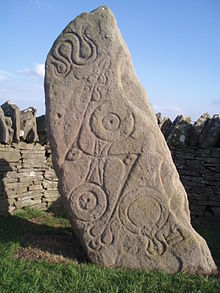User:Catfish Jim and the soapdish/Aberlemno1
56°41′33″N 2°46′51″W / 56.69255°N 2.78081°W
| Aberlemno 1 Pictish Stone | |
|---|---|
 | |
| Material | Old Red Sandstone |
| Height | 2.76 metres (9 ft 1 in) |
| Symbols |
|
| Created | Ninth Century CE |
| Discovered | 1811 |
| Place | Aberlemno, Angus, Scotland |
| Classification | Type I incised stone |
| Culture | Picto-Scottish |
The Aberlemno 1 Pictish symbol stone is one of several Pictish stones found in Aberlemno, Angus, Scotland.
Location
[edit]It is one of the three Pictish stones located in recesses in the dry stone wall at the side of the B9134 road leading out of Aberlemno at Crosston, towards Brechin. It is the northernmost roadside stone.
Description
[edit]An unshaped standing stone of Old Red Sandstone, Aberlemno 1 leans to the left as viewed from the front, symbol bearing face. It bears incised Pictish symbols, placing it under J Romilly Allen and Joseph Anderson's classification system as a Class I stone.[1] The carved symbols include a serpent, the double disc and Z-rod and the mirror and comb.[2] The meaning of these symbols is unknown. The rear face of the stone exhibits prehistoric cup marks, showing that it has been re-used.[3]
History
[edit]asdf
See also
[edit]Notes
[edit]- ^ Allen & Anderson 1903, p. 205
- ^ Allen & Anderson 1903, p. 205; Fraser 2008, p. 46
- ^ "Re: The Monument known as Aberlemno, cross slab and symbol stones NW of Village Hall", The Ancient Monuments and Archaeological Areas Act 1979: Entry in the Schedule of Monuments, 1998, retrieved 18 December 2009
References
[edit]- Allen, J.R.; Anderson, J. (1903), Early Christian Monuments of Scotland, vol. 3, Balgavies, Angus: Pinkfoot Press (1993 facsimile), ISBN 9781874012054
- Chalmers, George (1887). Caledonia: or a historical and topographical account of North Britain, from the most ancient to the present times with a dictionary of places chorographical and philological. Vol. 1 (new ed.). Paisley: Alex. Gardner. Retrieved 2 April 2023.
- Crombie, J. (1842). The new statistical account of Scotland, Parish of Aberlemno, Forfarshire. Retrieved 2 April 2023.
- Cruickshank, Graeme (1985), Nechtansmere 1300: A Commemoration, Forfar: Forfar & District Historical Society
- Cruickshank, Graeme (1991), The Battle of Dunnichen: an account of the Pictish victory at the Battle of Dunnichen, also known as Nechtansmere, fought on 20th May 685, Balgavies, Angus: Pinkfoot Press
- Cummins, WA (1999). The Picts and their symbols. Stroud, Gloucester: Sutton Publishing.
- Fraser, Iain (2008), The Pictish Symbol Stones of Scotland, Edinburgh: Royal Commission on the Ancienct and Historic Monuments of Scotland, ISBN 978-1-9024-1953-4
- Fraser, James E. (2006), The Pictish Conquest: The Battle of Dunnichen 685 and the Birth of Scotland, Stroud, Gloucester: Tempus
- Henderson, Isabel (1962), "Two Pictish Symbol Stones", Proceedings of the Society of Antiquaries of Scotland, 95: 219–222, retrieved 2 April 2023
- Jervise, Andrew (1856). "Notices descriptive of the localities of certain sculptured stone monuments in Forfarshire, &c. (Part I.)". Proceedings of the Society of Antiquaries of Scotland. 2: 187–201. Retrieved 2 April 2023.
- Laing, Lloyd (2000). "The Chronology and Context of Pictish Relief Sculpture". Medieval Archaeology. 34: 81–114. doi:10.1179/med.2000.44.1.81. S2CID 162209011. Retrieved 3 April 2023.
- Laing, Lloyd (2001), "The date and context of the Glamis, Angus, carved Pictish stones", Proceedings of the Society of Antiquaries of Scotland, 131: 223–239, retrieved 3 April 2023
- Mitchel, A. (1792). The statistical account of Scotland, Parish of Aberlemno, County of Forfar. Retrieved 2 April 2023.
- Nennius. "Historia Brittonum". Archived from the original on 27 July 2009. Retrieved 29 August 2009.
- Ritchie, Anna (1991), "The Battle of Dunnichen by Graeme Cruickshank (Book Review)", Pictish Arts Society, archived from the original on 25 August 2010, retrieved 5 August 2010
- Stevenson, Robert B.K. (1955), "Pictish Art", in Wainwright, F.T. (ed.), The Problem of the Picts, Edinburgh and London: Nelson
- Trench-Jellicoe, R. (1999), "A missing figure on slab fragment no 2 from Monifieth, Angus, the a'Chill Cross, Canna, and some implications of the development of a variant form of the Virgin's hairsyle and dress in early medieval Scotland", Proceedings of the Society of Antiquaries of Scotland, 129: 597–647, retrieved 2 April 2023
- Woolf, Alex (2006). "Dun Nechtain, Fortriu and the Geography of the Picts". The Scottish Historical Review. 85: 182–201. doi:10.1353/shr.2007.0029. S2CID 201796703.
- Ritchie, Anna (1997). Meigle Museum Pictish Carved Stones: The Official Souvenir Guide. Historic Scotland. ISBN 1-900168-27-8. OCLC 51913539.
